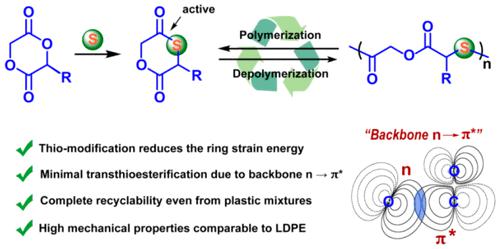当前位置:
X-MOL 学术
›
J. Am. Chem. Soc.
›
论文详情
Our official English website, www.x-mol.net, welcomes your
feedback! (Note: you will need to create a separate account there.)
Tough while Recyclable Plastics Enabled by Monothiodilactone Monomers
Journal of the American Chemical Society ( IF 14.4 ) Pub Date : 2023-01-03 , DOI: 10.1021/jacs.2c11502
Yanchao Wang 1 , Yinuo Zhu 1 , Wenxiu Lv 1 , Xianhong Wang 1 , Youhua Tao 1
Journal of the American Chemical Society ( IF 14.4 ) Pub Date : 2023-01-03 , DOI: 10.1021/jacs.2c11502
Yanchao Wang 1 , Yinuo Zhu 1 , Wenxiu Lv 1 , Xianhong Wang 1 , Youhua Tao 1
Affiliation

|
The current scale of plastics production and the attendant waste disposal issues represent an underexplored opportunity for chemically recyclable polymers. Typical recyclable polymers are subject to the trade-off between the monomer’s polymerizability and the polymer’s depolymerizability as well as insufficient performance for practical applications. Herein, we demonstrate that a single atom oxygen-by-sulfur substitution of relatively highly strained dilactone is an effective and robust strategy for converting the “non-recyclable” polyester into a chemically recyclable polymer by lowering the ring strain energy in the monomer (from 16.0 kcal mol–1 in dilactone to 9.1 kcal mol–1 in monothiodilactone). These monothio-modification monomers enable both high/selective polymerizability and recyclability, otherwise conflicting features in a typical monomer, as evidenced by regioselective ring-opening, minimal transthioesterifications, and quantitative recovery of the pristine monomer. Computational and experimental studies demonstrate that an n→π* interaction between the adjacent ester and thioester in the polymer backbone has been implicated in the high selectivity for propagation over transthioesterification. The resulting polymer demonstrates high performance with its mechanical properties being comparable to some commodity polyolefins. Thio-modification is a powerful strategy for enabling conversion of six-membered dilactones into chemically recyclable and tough thermoplastics that exhibit promise as next-generation sustainable polymers.
中文翻译:

单硫双内酯单体使坚韧而可回收的塑料成为可能
目前的塑料生产规模和随之而来的废物处理问题代表了化学可回收聚合物尚未开发的机会。典型的可回收聚合物在单体的可聚合性和聚合物的可解聚性之间进行权衡,并且在实际应用中性能不足。在此,我们证明了相对高应变的双内酯的单原子氧被硫取代是一种有效且稳健的策略,可通过降低单体中的环应变能将“不可回收”聚酯转化为化学可回收聚合物(来自双内酯中的16.0 kcal mol –1至 9.1 kcal mol –1在单硫双内酯中)。这些单硫代修饰单体具有高/选择性聚合性和可回收性,否则在典型单体中具有相互矛盾的特征,区域选择性开环、最小转硫酯化和原始单体的定量回收证明了这一点。计算和实验研究表明,聚合物主链中相邻酯和硫酯之间的 n→π* 相互作用与转硫酯化反应的高选择性有关。所得聚合物表现出高性能,其机械性能可与某些商品聚烯烃相媲美。
更新日期:2023-01-03
中文翻译:

单硫双内酯单体使坚韧而可回收的塑料成为可能
目前的塑料生产规模和随之而来的废物处理问题代表了化学可回收聚合物尚未开发的机会。典型的可回收聚合物在单体的可聚合性和聚合物的可解聚性之间进行权衡,并且在实际应用中性能不足。在此,我们证明了相对高应变的双内酯的单原子氧被硫取代是一种有效且稳健的策略,可通过降低单体中的环应变能将“不可回收”聚酯转化为化学可回收聚合物(来自双内酯中的16.0 kcal mol –1至 9.1 kcal mol –1在单硫双内酯中)。这些单硫代修饰单体具有高/选择性聚合性和可回收性,否则在典型单体中具有相互矛盾的特征,区域选择性开环、最小转硫酯化和原始单体的定量回收证明了这一点。计算和实验研究表明,聚合物主链中相邻酯和硫酯之间的 n→π* 相互作用与转硫酯化反应的高选择性有关。所得聚合物表现出高性能,其机械性能可与某些商品聚烯烃相媲美。

































 京公网安备 11010802027423号
京公网安备 11010802027423号